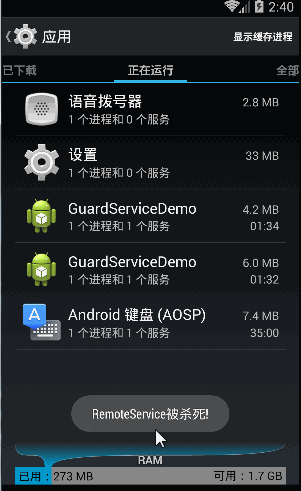这里主要记录下学习AIDL,通过AIDL来实现一个伪守护进程,也就是杀不死的进程(ps:这里指的是在一定情况下是杀不死,离微信,qq那些用NDK来实现的差很远,只是用于学习)。
先看下效果图

看了效果图是不是发现我这个demo里面有两个进程,杀死一个还能重启另外一个呢!下面主要记录下在应用层通过AIDL 和 Service来实现一个伪守护进程。看下面代码:
要实现守护我们是不是得启动2根服务来监听,如微信,360它们的应用都不会少于2根线程在后台运行,进行相互监听。那我们就先启动2根服务
MainActivity代码:
public class MainActivity extends Activity {
@Override
protected void onCreate(Bundle savedInstanceState) {
super.onCreate(savedInstanceState);
setContentView(R.layout.activity_main);
Intent localService = new Intent(this, LocalService.class);
this.startService(localService);
Intent remoteService = new Intent(this, RemoteService.class);
this.startService(remoteService);
}
}Manifest配置
<service android:name=".LocalService" />
<service android:name=".RemoteService" android:process=":remote"/>设置AIDL接口,新建一个.aidl为后缀的aidl文件,我这里随便提供了一个方法
package com.richard.guardservicedemo.aidl;
interface GuardAidl{
void doSomething();
}LocalService代码:
package com.richard.guardservicedemo;
import com.richard.guardservicedemo.aidl.GuardAidl;
import android.app.Service;
import android.content.ComponentName;
import android.content.Context;
import android.content.Intent;
import android.content.ServiceConnection;
import android.os.IBinder;
import android.os.RemoteException;
import android.util.Log;
import android.widget.Toast;
/**
* 本地服务
* @author Richard
*
*/
public class LocalService extends Service{
private MyBilder mBilder;
@Override
public IBinder onBind(Intent intent) {
if (mBilder == null)
mBilder = new MyBilder();
return mBilder;
}
@Override
public void onStart(Intent intent, int startId) {
super.onStart(intent, startId);
//在LocalService运行后,我们对RemoteService进行绑定。 把优先级提升为前台优先级
this.bindService(new Intent(LocalService.this, RemoteService.class),
connection, Context.BIND_ABOVE_CLIENT);
}
@Override
public int onStartCommand(Intent intent, int flags, int startId) {
// TODO Auto-generated method stub
return super.onStartCommand(intent, flags, startId);
}
private class MyBilder extends GuardAidl.Stub{
@Override
public void doSomething() throws RemoteException {
Log.i("TAG", "绑定成功!");
Intent localService = new Intent(LocalService.this, RemoteService.class);
LocalService.this.startService(localService);
LocalService.this.bindService(new Intent(LocalService.this, RemoteService.class),
connection, Context.BIND_ABOVE_CLIENT);
}
}
private ServiceConnection connection = new ServiceConnection() {
/**
* 在终止后调用,我们在杀死服务的时候就会引起意外终止,就会调用onServiceDisconnected
* 则我们就得里面启动被杀死的服务,然后进行绑定
*/
@Override
public void onServiceDisconnected(ComponentName name) {
Log.i("TAG", "RemoteService被杀死了");
Intent localService = new Intent(LocalService.this, RemoteService.class);
LocalService.this.startService(localService);
LocalService.this.bindService(new Intent(LocalService.this, RemoteService.class),
connection, Context.BIND_ABOVE_CLIENT);
Toast.makeText(LocalService.this, "RemoteService被杀死!", Toast.LENGTH_SHORT).show();
}
@Override
public void onServiceConnected(ComponentName name, IBinder service) {
Log.i("TAG", "RemoteService链接成功!");
try {
if(mBilder != null)
mBilder.doSomething();
} catch (RemoteException e) {
// TODO Auto-generated catch block
e.printStackTrace();
}
}
};
}RemoteService代码
package com.richard.guardservicedemo;
import com.richard.guardservicedemo.aidl.GuardAidl;
import android.app.Service;
import android.content.ComponentName;
import android.content.Context;
import android.content.Intent;
import android.content.ServiceConnection;
import android.os.IBinder;
import android.os.RemoteException;
import android.util.Log;
import android.widget.Toast;
/**
* 守护服务
* @author Richard
*
*/
public class RemoteService extends Service {
private MyBilder mBilder;
@Override
public IBinder onBind(Intent intent) {
if (mBilder == null)
mBilder = new MyBilder();
return mBilder;
}
@Override
public void onStart(Intent intent, int startId) {
super.onStart(intent, startId);
//在RemoteService运行后,我们对LocalService进行绑定。 把优先级提升为前台优先级
this.bindService(new Intent(RemoteService.this, LocalService.class),
connection, Context.BIND_ABOVE_CLIENT);
}
@Override
public int onStartCommand(Intent intent, int flags, int startId) {
return super.onStartCommand(intent, flags, startId);
}
private class MyBilder extends GuardAidl.Stub{
@Override
public void doSomething() throws RemoteException {
Log.i("TAG", "绑定成功!");
}
}
private ServiceConnection connection = new ServiceConnection() {
/**
* 在终止后调用,我们在杀死服务的时候就会引起意外终止,就会调用onServiceDisconnected
* 则我们就得里面启动被杀死的服务,然后进行绑定
*/
@Override
public void onServiceDisconnected(ComponentName name) {
Log.i("TAG", "LocalService被杀死了");
Intent remoteService = new Intent(RemoteService.this, LocalService.class);
RemoteService.this.startService(remoteService);
RemoteService.this.bindService(new Intent(RemoteService.this, LocalService.class),
connection, Context.BIND_ABOVE_CLIENT);
Toast.makeText(RemoteService.this, "LocalService被杀死!", Toast.LENGTH_SHORT).show();
}
@Override
public void onServiceConnected(ComponentName name, IBinder service) {
Log.i("TAG", "LocalService链接成功!");
try {
if(mBilder != null)
mBilder.doSomething();
} catch (RemoteException e) {
// TODO Auto-generated catch block
e.printStackTrace();
}
}
};
}到这里基本上就实现了一个伪守护进程,’杀不死应用’。呵呵,当然这还是可以杀死的。在应用层如果还想保险点,那就加广播监听,比如:电量变化的广播啊!
当然,不推荐这样写代码。因为这不是正确的实现方式,也不是保险的实现方式,这只是一个然并卵的实现方式。不推荐用于实际开发。





















